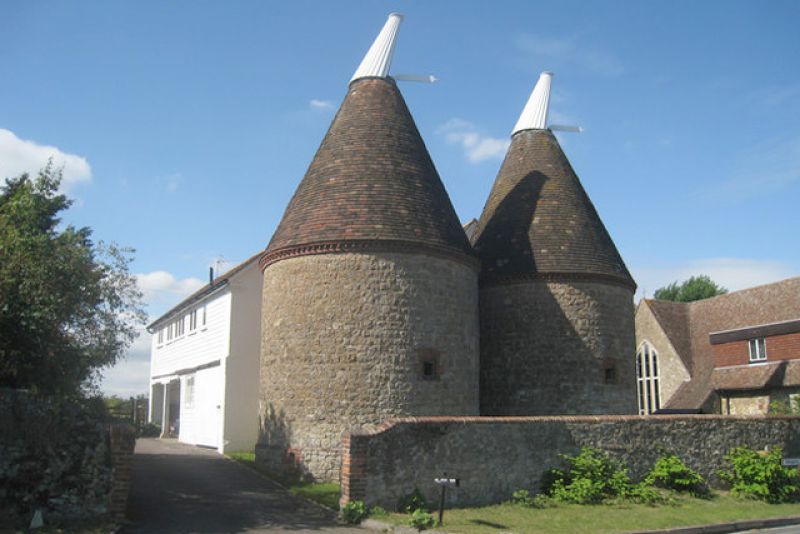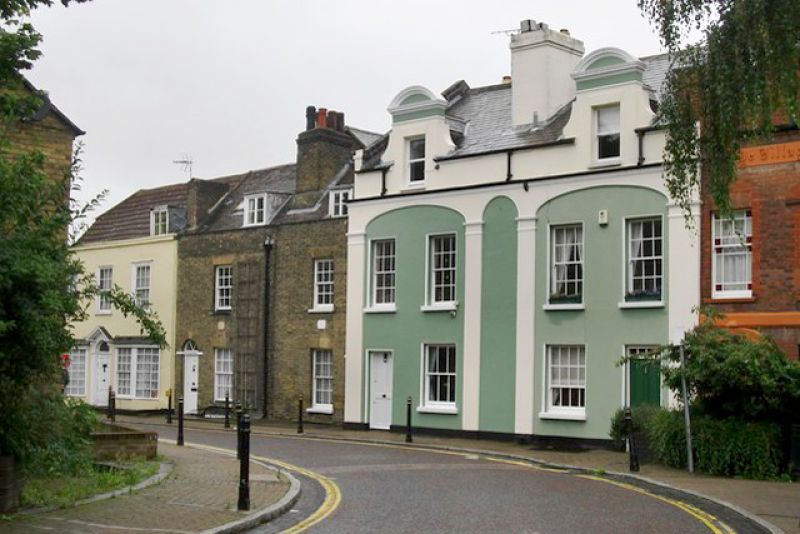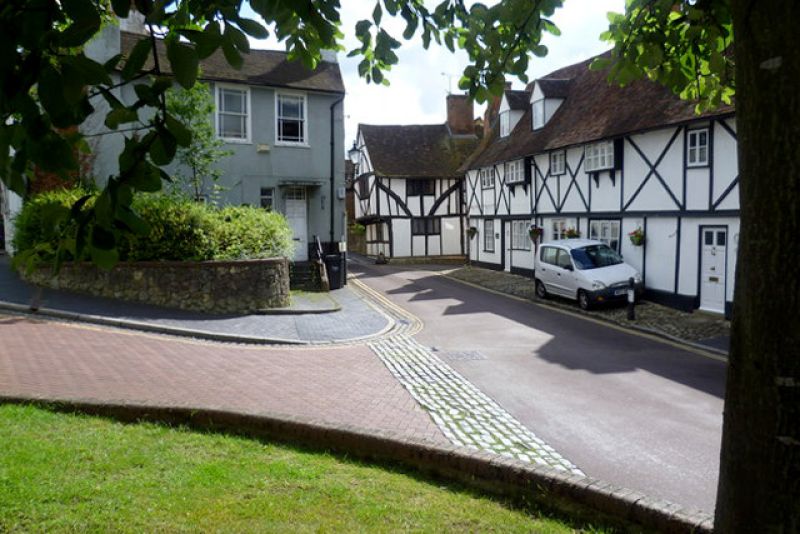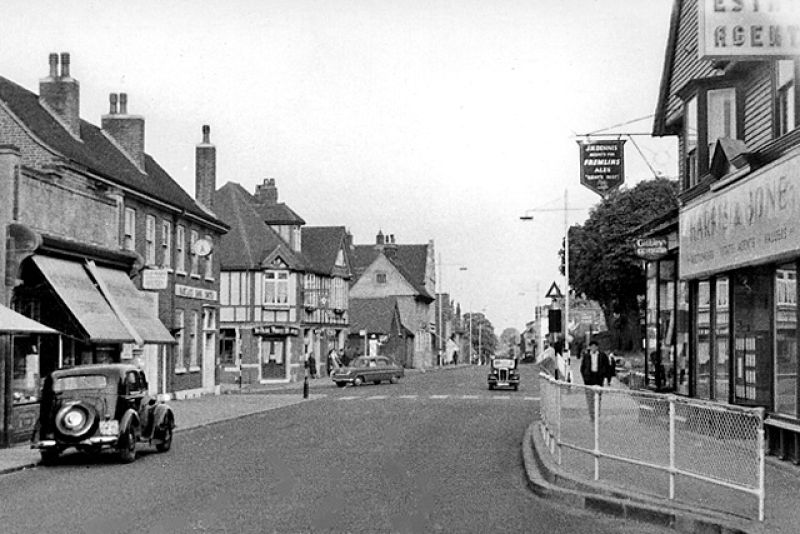Created Date:
Last Modified:
Chislehurst electric car trials
The first national electric car trials.
Location
The Bull’s Head Hotel, 5 Royal Parade, Chislehurst, BR7 6NR.
Date
5 - 9th November 1900
-
 A small gathering outside the Bull's Head Hotel examining La Toujours Contente, the brainchild of Ferdinand Porsche, source: The Autocar, 17th November 1900
A small gathering outside the Bull's Head Hotel examining La Toujours Contente, the brainchild of Ferdinand Porsche, source: The Autocar, 17th November 1900 -
 One of the electric dogcarts backing out of the charging station yard, source: Autocar, 10th November 1900
One of the electric dogcarts backing out of the charging station yard, source: Autocar, 10th November 1900 -
 An electric phaeton and dog cart leaving Royal Parade on the first day of the Trials; both cars were designed for town use, source: Autocar, 10th November 1900
An electric phaeton and dog cart leaving Royal Parade on the first day of the Trials; both cars were designed for town use, source: Autocar, 10th November 1900 -
 The Powerful car was consistently successful throughout the Trials. The shop front visible in the background can still be recognised today, source: Autocar, 10th November 1900
The Powerful car was consistently successful throughout the Trials. The shop front visible in the background can still be recognised today, source: Autocar, 10th November 1900 -
 The Toujours Contente struggled in the wet and muddy conditions; two of its electric motors are clearly visible from this front view, source: Autocar, 10th November 1900
The Toujours Contente struggled in the wet and muddy conditions; two of its electric motors are clearly visible from this front view, source: Autocar, 10th November 1900 -
 The Canadian Still was very much a ‘horseless carriage’ in design, but preformed consistently throughout the Trials, source: Autocar, 10th November 1900
The Canadian Still was very much a ‘horseless carriage’ in design, but preformed consistently throughout the Trials, source: Autocar, 10th November 1900 -
 The Krieger Powerful entering Sidcup on the last day of the event, source: Autocar, 17th November 1900
The Krieger Powerful entering Sidcup on the last day of the event, source: Autocar, 17th November 1900
Commentary
On 13th October 1900, it was announced that the Automobile Club would be holding trials of electrically-propelled vehicles between 5th and 9th November. Entries were to be submitted by 2nd November, with a fee of two guineas per vehicle, per trial. Competitors were required to provide a seat for an official observer on each vehicle, and the same batteries were to be used throughout.
However, the location and the starting point of the event were deliberately kept secret (even to those taking part) until just two days before the trials began, although the notice did say that the routes on which they would be run would be “within 50 miles of London”.
It is not entirely clear why the village of Chislehurst was chosen to host the competition; although using the Bull’s Head Hotel as the headquarters and starting point was no doubt partly down to the fact that it was only about 200 yards from the Chislehurst Electric Light Station*, where the cars’ batteries were charged each night.
Although the legal barriers to motoring in Britain had been removed in 1896 with the passing of the Locomotives on Highways Act, there was still a sizable section of the population in 1900 who were still not convinced of the value of mechanised, as opposed to horse-drawn, personal transport.
In an attempt to remedy this, the Automobile Club had, in that year, staged a number of trials and exhibitions designed to convince the general public of the viability of the motor car as means of everyday, reliable, transport. Organised at the request of the electric car manufacturers, the Chislehurst Electric Trials was one such event.
The trials were due to begin on Monday 5th November, but a combination of bad weather and the difficulty of arranging for the engineers to drive the cars down from London, meant that the first car didn’t reach Chislehurst until 6.00pm on Monday evening.
Despite the start being delayed by 24 hours, just seven of the 13 original entries set off from the Bull’s Head Hotel on Tuesday morning, with two joining later in the day. The course they were given ran for 34¾ miles through Foots Cray, Farningham, Wrotham, Poll Hill, and then back to Chislehurst, via Orpington. Drivers who completed the distance were free to continue on an 8¾ mile circular route through Orpington, St Mary Cray and St Paul’s Cray, as many times as they wished.
The first day’s results set a pattern that would largely be repeated for the rest of the week. Way out in front, covering a total distance of 59 miles on a single charge was the “Powerful”, a car made in Paris by the Kriéger Company of Electric Vehicles. Probably specially built for the event, it had two electric motors driving the front wheels; its batteries were manufactured by the British Leecoll Electric Battery Company.
The Powerful appears to have had two particular strengths: the greater efficiency and lighter weight of its zinc-based batteries, and the design of its electric motors that could act as generators when braking or going downhill.
Four other cars completed the circuit, two more got just passed the halfway point, and the remaining two vehicles retired after seven miles.
The most advanced car in the trial, although on this occasion not the most successful, is the one perhaps best remembered today. Commissioned by the businessman and motor enthusiast Earnest Hart, from Luton, it was built by the Austrian coachbuilder, Jacob Lohner & Co., and named “La Toujours Contente” (Forever Satisfied) as a light-hearted reference to “La Jamais Contente”, the car in which the Belgian inventor and electric car pioneer Camille Jenatzy had traded land speed records the previous year with his French rival, Count Chasseloup-Laubat.
La Toujours Contente was designed by a 25-year-old engineer by the name of Ferdinand Porsche who, in the early stages of his career, was very much involved in the development of electric vehicles. The car was unusual in having an electric motor on each wheel, powered centrally by 70 electric cells which, for protection, were mounted on a sprung platform hanging inside the steel chassis. It had four forward speeds and three reverse, together with electric braking, and battery regeneration on the overrun.
Whilst undoubtedly a very impressive piece of machinery, the technical sophistication of the car came at some cost; its batteries alone weighed almost two tons, and the four electric motors added a further half-a-ton in weight. It was by far the heaviest vehicle in the trials, which certainly cancelled out its power advantage and made it hard to handle in the difficult road and weather conditions. With Ferdinand Porsche himself at the wheel, accompanied by the obligatory observer, La Toujours Contente covered a distance of 34 miles on the first day. However, it was blighted with tyre failures and fused wiring, and was subsequently withdrawn, taking no further part, save for an unofficial run on the last day. Sadly Mr Porsche didn’t fare too well either, succumbing midweek to a heavy cold.
Just five vehicles took part in the Trials over the remaining three days: These were: the Powerful, a two-seater Joel car, two electric dogcarts, and a four-seater Canadian Still. Both the electric dogcarts (like the Still) had solid tyres, and were primarily geared for town use, although one had recently covered the 50-odd miles from London to Brighton on a single charge. At 12 hundredweight, the Joel car was one of the lighter competitors, in contrast to the Toujours Contente which, according to various contemporary reports, weighed between three and four tons.
On Wednesday, the cars followed a 30-mile route through Cudham, Knockholt and Green Street Green, which included a 1 in 9 gradient, with the Powerful car once again, by a small margin, covering the greatest distance.
Thursday’s trial, through Farningham, Eynsford and Shoreham again included a number of gradients; with four out of the five cars completing the full 30-mile course.
Given the state of the roads, Friday’s route was altered to one of a more level nature on an eight-mile circle through Sidcup, Eltham and Blendon. As before, the Powerful car covered the greatest distance (65 miles), and was declared the winner, although one of the electric dogcarts did manage four circuits totalling nearly 40 miles.
A month after the event, an article appeared in the Automotor Journal written by Carl Oppermann, a manufacturer of electric vehicles. He had been hoping to drive one of his own cars in the trials, but had been unable to take part due to the death of his son the day before the competition began.
Like several people at the time, he criticised the choice of location, stating that the hilly nature of area around Chislehurst made it entirely unsuitable for electric cars.
He also, perhaps surprisingly given his profession, went on to say that electric cars had limited viability, and could only realistically be used in towns and cities, over good roads and relatively short distances. The editor of the magazine commented that Mr Oppermann was being unduly pessimistic, but in fact he probably turned out to be more right than wrong.
For a few years, electrically-powered cars did have a role, particularly in London, as taxis, but by 1910, the internal-combustion engine had certainly taken the lead, out-manoeuvring both steam and electrically-powered vehicles with its greater range and flexibility.
* This was located to the rear of what is today (2023) the Royal Dry Cleaners, 12 Royal Parade, Chislehurst BR7 6NR.
With thanks to Gordon Brooks, Joanna Friel, and members of the Chislehurst Society for their help in the preparation of this article.
Further details
• A history of Electric Cars, Nigel Burton, The Crowood Press, 2013.










